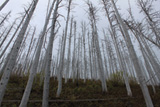Protecting Species and Habitats
Many species of plants and animals face declining populations and extinction. Identifying and appropriately listing threatened, endangered or species of concern as well as threatened habitats in the watershed is the first step in helping to conserve native populations and to protecting biological diversity. By including this information in land use planning and management, we may be able to prevent further losses of individual species and ecosystem damage, and preempt the need for costly restoration programs. Protecting biodiversity increases the ecosystem’s resiliency—the ability of species and systems to reorganize and persist post-disturbance. Resiliency becomes increasingly critical in the face of natural and human-caused disturbances such as climate change and pressure from invasive and exotic species. Essentially, the greater a system’s biodiversity, the greater its ability to adapt to change. There is a strong link between biological diversity and ecological integrity.
Endangered and Threatened Species and Critical Habitat Designation
The U.S. Endangered Species Act of 1973 (ESA) expresses the nation’s commitment to preventing extinctions and ensuring biodiversity. The U.S. Fish and Wildlife Service in the Department of the Interior and the National Oceanic and Atmospheric Administration (NOAA) - Fisheries in the Department of Commerce share responsibility for administration of the Endangered Species Act. The rigorous process by which plants and animals are listed includes a scientific review proposal, a peer review process, a public peer review process, and a final listing determination.
According to the ESA, an endangered species is one that is in danger of extinction throughout all or a significant part of its range. A threatened species is one that is likely to become endangered in the foreseeable future. Candidate species are those for which enough information exists to propose them as endangered or threatened. Individual species loss impacts overall biodiversity and can have rippling effects on an entire ecosystem. Figure 2.48 includes listed species in the Flathead Watershed.
Montana Natural Heritage Program
The Montana Natural Heritage Program provides information on Montana’s species and habitats, emphasizing those of conservation concern. The Program is operated by the University of Montana in partnership with the Montana State Library. Species of Concern are native plants and animals that are at-risk due to declining population trends, threats to their habitats, restricted distribution, or other factors. Designation as a Montana Species of Concern or Potential Species of Concern is based on the Montana Status Rank, and is not a statutory or regulatory classification
| USFWS Species Endangered, Threatened Plants & Critical Habitat | |||
| Species Type | Common Name | Scientific Name | Status |
| Flowering Plant | Spalding’s Campion | Silene spaldingii | LT, CH |
| Flowering Plant | Water Howellia | Howellia aquatilis | LT |
| LT - Listed Threatened | |||
| CH - Designated Critical Habitat | |||
| Figure 2.48: USFWS Endangered Plants. Source: U.S. Fish & Wildlife Services | |||
These designations are designed to provide information to help resource managers make proactive decisions regarding species conservation and data collection priorities. Species and ecosystems are ranked globally and nationally by the international organization NatureServe, the leading source of information about rare and endangered species and threatened ecosystems. There are currently over 100 plant species in the watershed on the Species of Concern list.
British Columbia Ministry of Sustainable Resource Management Wildlife at Risk
The Flathead Watershed crosses into the southern tip of the Southern Rocky Mountain Management Plan (SRMMP) area in British Columbia. Linking the Canada-U.S. border, this area includes the Flathead, Bull, Wigwam, and Elk Watersheds. In B.C., species and ecosystems are first ranked using NatureServe. The Conservation Data Centre (CDC)—part of the Ministry of Sustainable Resources Management—hen assigns provincial ranks (Conservation Status Rank or SRANK) based on each species status within the province.
In order to make the ranking more easily understood, species are then placed on one of three lists, the Red List, Blue List, or Yellow List. The Red List includes any ecological community and indigenous species and subspecies that is extirpated, endangered or threatened. Extirpated species no longer exist, endangered species face imminent extirpation or extinction, and threatened species are likely to become endangered if limiting factors are not reversed.
The Blue List contains species of special concern (previously called “vulnerable”): indigenous species and subspecies at risk because of their particular sensitivity to human activity or natural events. The Yellow List contains all species not listed on the Red or Blue Lists. This includes common and uncommon species, and in some cases species that occur in low numbers, in a small range, have shown some decline in numbers, or are considered to have long-term threats.

